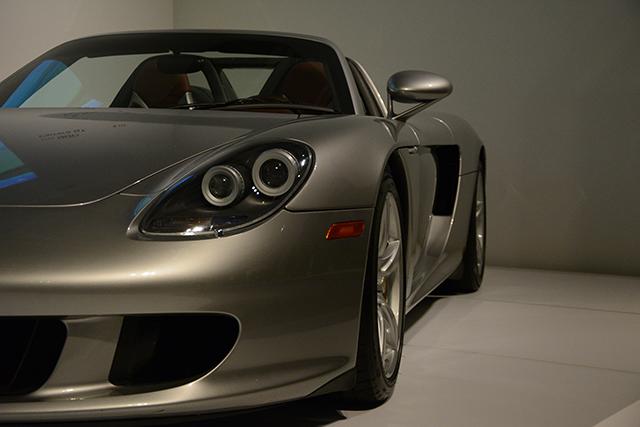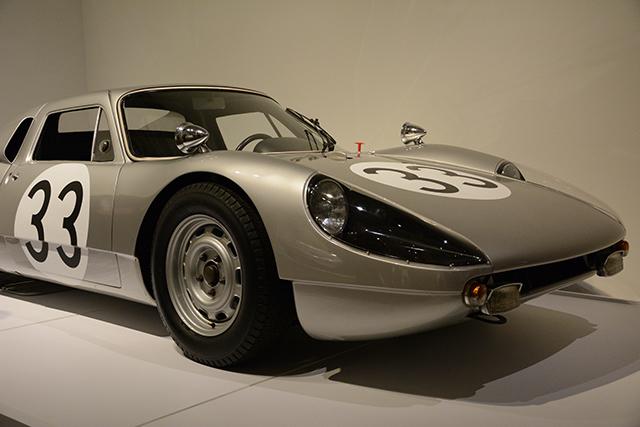Porsche is a company that strives to achieve excellence in everything it does, whether it is a car for Sunday drives with the family, or the screaming, twelve-cylinder beast whose home is on the race track. The exhibition Porsche by Design: Seducing Speed at the North Carolina Museum of Art aims to make the story of the company and the family behind it accessible to the public. Originally meant to close on Jan. 20, the exhibit’s stay has been extended to Feb. 2.
Porsche. Anybody who considers themselves a car enthusiast knows the name. However, what many might not know about the renowned German performance-car manufacturer is the legacy that, to this day, goes into each and every new design to roll off the assembly line.
The story starts with Ferdinand Porsche, born in Bohemia (now the Czech Republic) in 1875. Though Porsche was entirely self-taught, he quickly became chief engineer for Lohner, an electric-drive vehicle manufacturer. By the age of 25, he had designed his first car, the 64 Berlin-Rom Racer. It was meant to compete in a road rally between Berlin and Rome, but never got the opportunity due to the hostilities of World War II.
By the early 1930s, Porsche had started his own automotive consulting firm in Austria. It stayed there until after the war was over and then moved to its permanent location in Stuttgart, Germany. At this time, Porsche’s son, Ferdinand “Ferry” Porsche, took charge of the company, and it was his ambition to create a sports car. This came to be in the form of the 356 Gmünd Coupe, which is the second car in the exhibition and would form the foundation of the Porsche design philosophy for years to come.
This is illustrated in the next room of the exhibit, which features two more cars from the 356 line. First is the 356 Speedster 1600 Super, which the curator of the exhibit, Barbara Wiedemann, describes as, “A car to drive during the week and race on the weekends.” The particular Speedster on display belonged to Steve McQueen, so it certainly did some racing in its time.
Continuing on, the next display is the 356B 1600 Carrera GTL Abarth Coupe, which Ferry Porsche designed in collaboration with the renowned Carlo Abarth. Abarth’s influence is evident in the cars shape, which is narrower and lower with more subdued curves than the typical Porsche design. This was to become the first racing version of the 356.
Following is the largest part of the exhibit, which contains cars meant almost entirely for racing. There is the 550 Spyder Prototype, the first pure racing car ever made by Porsche, and the 904, which was designed by Ferry Porsche’s son, Ferdinand “Butzi” Porsche, upon entering the company. He designed it completely on his own and in only six months. Wiedemann said this is her personal favorite and is “like a sculpture.”
Next we come to the 718 RS60, which is quite an aesthetic departure from the past few models. This model struck me as more blunt; it seems bigger and rounder than the previous versions. It would later become the design inspiration for the modern-day Porsche Boxster. Then comes the last non-racing car on display until the 911 series, and the last of the 356 line, the 356C Carrera 2 Coupe.
The next room of the exhibit is full of slightly more modern Porsche race cars, including its first and only Formula 1 design, the 804, which looks like nothing more than wheels strapped to a long, silver bullet. Along a wall sits the 917 16-cylinder Spyder, the 917K, the 908 LH Coupe, the 935 “Baby” and the 962C. The 16-cylinder prototype was deemed too heavy and long to be driven in a race. The 917K, 908, 935 and 962C, however, all saw many successful races.
No discussion of Porsche would be complete without mention of the 911, by far its longest-running and most commercially successful design. Three are on display here: the original 901 (later re-branded as the 911) Prototype, a racing version dubbed the 911 Carrera RSR and a 911 Sport Classic Carrera, built in 2010. While obviously more contemporary in design, the latter two cars clearly have major design elements that can be traced all the way back to the 1963 original.
Porsche has also dabbled in super cars. That is, cars that have the performance of Porsche race cars, but the styling and driving experience of Porsche road cars. The 959 and 980 Carrera GT are two such cars on display at the North Carolina Museum of Art. The outward class of these two cars belies the ferocity and racing pedigree that rests under the surface.
The Panamericana grandly sits on its own platform on the opposite side of the room. It is a one-of-a-kind piece, and was given to Ferry Porsche by his design team for his 80th birthday. It was treated as a chance to experiment with designs that were not considered classically Porsche.
Last in the lineup of the main exhibit is the 911 GT3R Hybrid Prototype racecar. Here, Porsche looks to the future of racing by implementing a kinetic energy recovery system and a hybrid drive train. This consists of a flywheel that stores energy mechanically upon braking, then channels that torque back into the electric motors at the front wheels. This results in an additional 200 horsepower at the driver’s disposal coming out of turns.
In the West building of the museum, set apart from the main exhibit, resides the 356C Cabriolet that once belonged to Janis Joplin. On the entirety of the exterior is a mural to the rock and roll lifestyle of the ‘60s, painted by Dave Richards.
It is hard not to at least mention every car on display, as the exhibit really does showcase the most influential cars throughout Porsche’s history. Each one is uniquely shaped by a family with an undying desire to excel. Every car on display is simultaneously a rolling work of art and an incredible piece of engineering brilliance.
A 1964 Porsche Type 904/6 Prototype rests in the North Carolina Museum of Art as a part of the Porsche by Design exhibit. The exhibit includes a number of Porsches from 1938 2013 and runs until Feb. 2.









